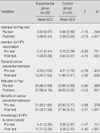Abstract
Purpose
This study was done to identify the effects of a Human Papillomavirus (HPV) linked to cervix cancer prevention education program for unmarried university female students. A new model in the cervix cancer prevention is provided.
Methods
The research design was a nonequivalent control group pretest-posttest design. Participants were 63 female students in one of two university in an experimental group (29 students) and control group (34 students). After 4 weeks education, the differences between the two groups in the measurement variables were compared. Twelve weeks later, a follow-up test was done for experimental group only.
Results
After the education, experimental group showed significantly higher scores in all variables, the intention for Pap test (Z=-3.73, p<.001), intention for HPV vaccination (Z=-3.14, p=.002), general cancer prevention behavior (Z=-2.20, p=.028), attitudes to Pap (Z=-3.23, p=.001), benefits of cancer prevention behavior (Z=-3.97, p<.001), and HPV linked to cervix cancer knowledge (Z=-5.40, p<.001). In the follow-up study, the experimental group showed intermediate effects in intention for Pap test, intention of HPV vaccination and HPV linked to cervix cancer knowledge as well as short term effects in general cancer prevention behavior, attitudes to Pap and benefits of cancer prevention behavior.
Conclusion
The program developed for this study on prevention education of HPV linked to cervix cancer was effective for unmarried university students in the short term and intermediate duration. Other educational approaches should be developed and short term effects and longitudinal changes of the education should be assessed. This education program should also be replicated for other female groups including unmarried working women or female adolescents.
Figures and Tables
References
1. Armstrong LL. Predicting cervical screening in college women: A test of the theory of reasoned action. 2001. Missoula, USA: University of Montana;Unpublished doctoral dissertation.
2. Choe SA. Factors influencing continuous Pap smear participation in women employed in a general hospital. 2002. Seoul: Yonsei University;Unpublished master's thesis.
3. Choi KA, Kim JH, Lee KS, Oh JK, Liu SN, Shin HR. Knowledge of human papillomavirus infection and acceptability of vaccination among adult women in Korea. Korean Journal of Obstetrics and Gynecology. 2008. 51:617–623.
4. Cohen J. Statistical power analysis for the behavioral sciences. 1988. 2nd ed. Mahwah: Lawrence Erlbaum Associates.
5. Fernandez-Esquer ME, Ross MW. The importance of psychosocial factors in the prevention of HPV infection and cervical cancer. International Journal of STD & AIDS. 2000. 11:701–713.
6. Fletcher PC, Bryden PJ. Preliminary examination of cervical health practices and knowledge among university aged females. College Student Journal. 2005. 39:469–477.
7. Ingledue K, Cotrrell R, Bernard A. College women's knowledge, perceptions, and preventive behaviors regarding Human Papillomavirus infection and cervical cancer. American Journal of Health Studies. 2004. 19:28–34.
8. Ji SW. A study on the knowledge of Human Papillomavirus and cervical cancer in nurses. 2009. Gangneung: Kwandong University;Unpublished master's thesis.
9. Jo SJ. Development and evaluation of community based program for promotion of cervical cancer screening via internet. 2003. Seoul: The Catholic University of Korea;Unpublished doctoral dissertation.
10. Joo WD, Kim SH, Kim DY, Suh DS, Kim JH, Kim YM, et al. Prevalence of Human papillomavirus infection in Korean women: Risk of abnormal Pap smear and cervical neoplasia. Korean Journal of Gynecology Oncology Colposcopy. 2004. 15:309–316.
11. Kim HW, Ahn HY. Study on the knowledge of Human papillomavirus in female university students. Korean Journal of Women Health Nursing. 2007. 13:13–20.
12. Kim JU. Relationship between middle aged women's cognitive perceptual factors and examination for detection of cancer. 2006. Incheon: Gachon Medical University;Unpublished master's thesis.
13. Kim M. The effect of nursing intervention on the rescreening compliance of cervical cancer screening clients. 2005. Gwangju: Chonman National University;Unpublished doctoral dissertation.
14. Kim SH. Study on the characteristics and related factors of female cancer's screening and repeat screening. 2004. Busan: Pusan National University;Unpublished master's thesis.
15. Marlow LA, Waller J, Wardle J. Public awareness that HPV is a risk factor for cervical cancer. British Journal of Cancer. 2007. 97:691–694.
16. Annual report of cancer incidence (2005) and survival (1993-2005) in Korea. Ministry of Health, Welfare and Family Affairs. 2008. 10. 30. Retrieved from January 10, 2009. from http://www.w3.org/1999/xlink" xlink:href="http://stat.mw.go.kr/homepage/data/part_data_content.jsp?menu_id=21&curr_page=1&board_bcd=2&ctrl_command=doNothing&seq_no=10312.
17. Early examination of cervical cancer. National Cancer Information Center. 2009. 01. 23. Retrieved July 9, 2009. from http://211.114.9.232/nciapps/user/basicinfo/each_cancer_main.jsp.
18. Park SM, Chang SB, Chung JW. Content analysis on cognitive affective experience in Pap smear participants. Journal of Korean Society of Maternal Child Health. 2004. 8:37–48.
19. Risi L, Bindman JP, Campbell OM, Imrie J, Everett K, Bradely J, et al. Media interventions to increase cervical screening uptake in South Africa: An evaluation study of effectiveness. Health Education Research Theory & Practice. 2004. 19:457–468.
20. Sabate R, Feinstein L. The role of education in the uptake of preventive health care: The case of cervical screening in Britain. Social Science & Medicine. 2006. 62:2998–3010.
21. Shin HR, Franceschi S, Vaccarella S, Roh JW, Ju YH, Oh JK, et al. Prevalence and determinants of genital infection with papilloma virus, in female and male university students in Busan, South Korea. Journal of Infectious Disease. 2004. 190:468–476.




 PDF
PDF ePub
ePub Citation
Citation Print
Print






 XML Download
XML Download